FAQ & Travel Tips
- How to get here
- Where to stay
- What to bring
- Food & Drink
- Money, Tele & Internet
There are direct flights to Narsarsuaq (South Greenland) from Denmark (Copenhagen, CPH) and Iceland (Reykjavik, KEF) in the high season from mid-June to early September.
Tickets can be purchased at the airlines’ websites:
Air Greenland flies from Copenhagen to Narsarsuaq.
Icelandair flies from Reykjavik to Narsarsuaq. Iceland air provides connecting flights from many major cities in US and EU. With just one stopover in Reykjavik.
Several airlines fly from Europe and the US to Denmark and Iceland.
Please notice, flight tickets are not included in any of our tours or products.
Hotels
There are hotels in the towns of Narsarsuaq, Narsaq, Qaqortoq and Nanortalik. Rated by European standards, these establishments feature 2 to 4-star accommodation levels. Most hotels have rooms with private facilities as well as shared facilities. All hotels have a restaurant and breakfast is included in the price of an overnight stay.
At the Country Hotel in Igaliku the rooms have shared facilities, and the cabins have private facilities. All meals are served in the hotel restaurant.
Guest house
What we call “guesthouse” accommodation in our package tours refers to establishments at a number of different locations that feature double-room occupancy with bed linens, towels and shared facilities. Breakfast is included in the price. There is often access to a small kitchen, but you also have the opportunity to buy dinner either at the guesthouse or nearby.
Hostels
There are hostels in every town and in the village of Qassiarsuk. Hostels are a budget alternative to hotels. Instead of restaurants they have well-equipped kitchens where you can make your own meals. Standards vary somewhat from place to place, but most hostels are modern with a cosy atmosphere. There are shared bathrooms and toilets, and rooms that accommodate either two, four or six people. You should bring your own sleeping bag and towel. In some places this can be rented and you can often order breakfast. No discounts are available on Greenlandic hostels for customers who are members of Hostelling International.
Farm accommodation
Many sheep farms in southern Greenland offer accommodation. This is a unique opportunity to get close to the life of a Greenlandic family. The farms are often situated in the midst of breathtaking wilderness landscapes and only accessible by boat or by travelling on long, winding gravel roads. But it’s well worth the journey. These sheep farms have all of the amenities of modern life and you will be warmly welcomed. Standards vary between hostel and guesthouse accommodation. Some have sleeping bag accommodation and you can make your own meals, others feature double rooms with bedding and an opportunity to order meals.
For our package tours we recommend:
- A sleeping bag and towel (only if you stay in hostels)
- Slippers or sandals (for use indoors when you stay at hostels/farms or visit a Greenlandic home)
- Hiking boots or solid walking shoes
Clothes according to the layer-to-layer principle:
- Wind and waterproof outerwear
- Sweater or fleece for insulation
- T-shirts and long-sleeved blouses (it can get really hot in the sun on land)
- A knit hat and gloves (it can be rather chilly on a boat trip to the ice fjord)
There are laundry facilities at the hostels in Narsarsuaq, Narsaq and Qaqortoq
- A mosquito net and mosquito repellent (which can also be purchased at Blue Ice Café). The mosquitoes are worst in June and early July in southern Greenland. There may be small, annoying flies in August. Mosquitoes are virtually non-existent in sheep farming areas, but can be troublesome in Narsarsuaq and mountain areas with few or no sheep
- Sunglasses and sun lotion
We recommend that you pack your things in a duffle bag or backpack instead of a hard suitcase with wheels. Bags are easier to transport by boat and car, and small suitcase wheels are not conducive for use on gravel roads.
Meat and fish are the foundation of the Greenlandic diet, so be prepared for high-protein fare with relatively few vegetables and side dishes. In South Greenland you will primarily be served lamb, but also musk ox, reindeer and whale meat. Cod, trout and shrimp are the most common fish and seafood used in South Greenlandic cuisine. If you have an opportunity to cook your own meals, you won’t want to miss out on a visit to the local meat and fish market, where hunters and fishermen sell the catch of the day. In South Greenland several sheep farmers have also begun to grow potatoes, turnips, lettuce and cabbage on a larger scale and you can enjoy this fresh produce if you are travelling in late summer.
Opening hours
There are grocery stores (the Pilersuisoq chain) in the villages of Narsarsuaq, Qassiarsuk and Igaliku, where you can buy canned, dried and frozen food, and to a limited extend fresh products. If your package tour includes one of the major towns, we always recommend that you buy food in a supermarket there before continuing on to a small village.
In the towns of Narsaq, Qaqortoq and Nanortalik shops are generally open from 8-9 am to 5-6 pm on weekdays, with slightly shorter opening hours on Saturdays and Sundays. In the settlements (Narsarsuaq, Qassiarsuk and Igaliku) shop opening hours are somewhat more limited: weekdays often from 10 am to 3 pm, Saturdays 10-12 am and closed on Sundays. So please be aware that if you arrive in Narsarsuaq by plane from Iceland on a Saturday afternoon, you will not be able to do any shopping in Narsarsuaq, Qassiarsuk or Igaliku before Monday morning!
About dining in villages and on sheep farms
We always recommend that you take the opportunity to eat locally and taste different Greenlandic dishes when you visit a sheep farm or a small settlement. However, please do not expect a large variety of dishes (à la carte menu), as well as a special children’s menu or vegetarian dishes at such places, as shopping facilities and the choice of products are limited. If you are a vegetarian or have a food allergy (e.g., allergic to gluten), you may want to consider bringing some food along with you, unless you will be staying in the vicinity of a supermarket in one of the major towns!
Costs
The price level of food in shops is roughly the same as in the rest of Northern Europe. Fresh fruit and vegetables, alcoholic drinks and sweets are the most expensive. See below for indicative prices for meals in cafes/restaurants.
Lunch at cafes/hotels: DKK 120-150
Dinner at cafeteria / sheep farm / restaurant: DKK 120 / 200-300 / 200-400
These prices are without drinks
1 beer at a bar/restaurant: from DKK 50
1 bottle of wine at a restaurant: from DKK 230
Currency and Credit cards
The currency used in Greenland is the Danish krone (DKK). Please note that there is no bank or ATM in Narsarsuaq. You can pay by credit card in stores (also in the settlements), at hotels, restaurants (including the Igaliku Country Hotel) and at tourist offices. However, it is a good idea to have a small amount of cash with you, especially if you are going to stay and dine on a sheep farm, where cash is the only means of payment. At the Blue Ice Café we accept – in addition to credit cards – euros and US dollars. There are ATMs in the towns of Narsaq, Qaqortoq and Nanortalik.
Telephony
There is mobile coverage in all towns and villages. Most European telecommunications providers have roaming agreements with Tele Greenland, but it might be quite expensive to use your phone in Greenland. You should also not rely on your mobile phone as a means of communicating with the outside world on a hiking trip, as there are many places in the countryside/mountains where you will not have a signal. If you are planning a longer hiking or kayaking trip in isolated areas, for safety reasons we recommend that you rent a satellite phone (Blue Ice Café).
Internet
There is wireless internet at most hotels and hostels in the towns (including Narsarsuaq and the Igaliku Country Hotel). At most tourist offices you can also borrow a computer to check your emails and so on. At Blue Ice Café you will find a wireless hot-spot. What all of these points of access have in common is that you pay for the use of the internet in Greenland and – compared to the rest of Europe – it is quite expensive.
Our destinations in South Greenland
Read more about some of the destinations in South Greenland
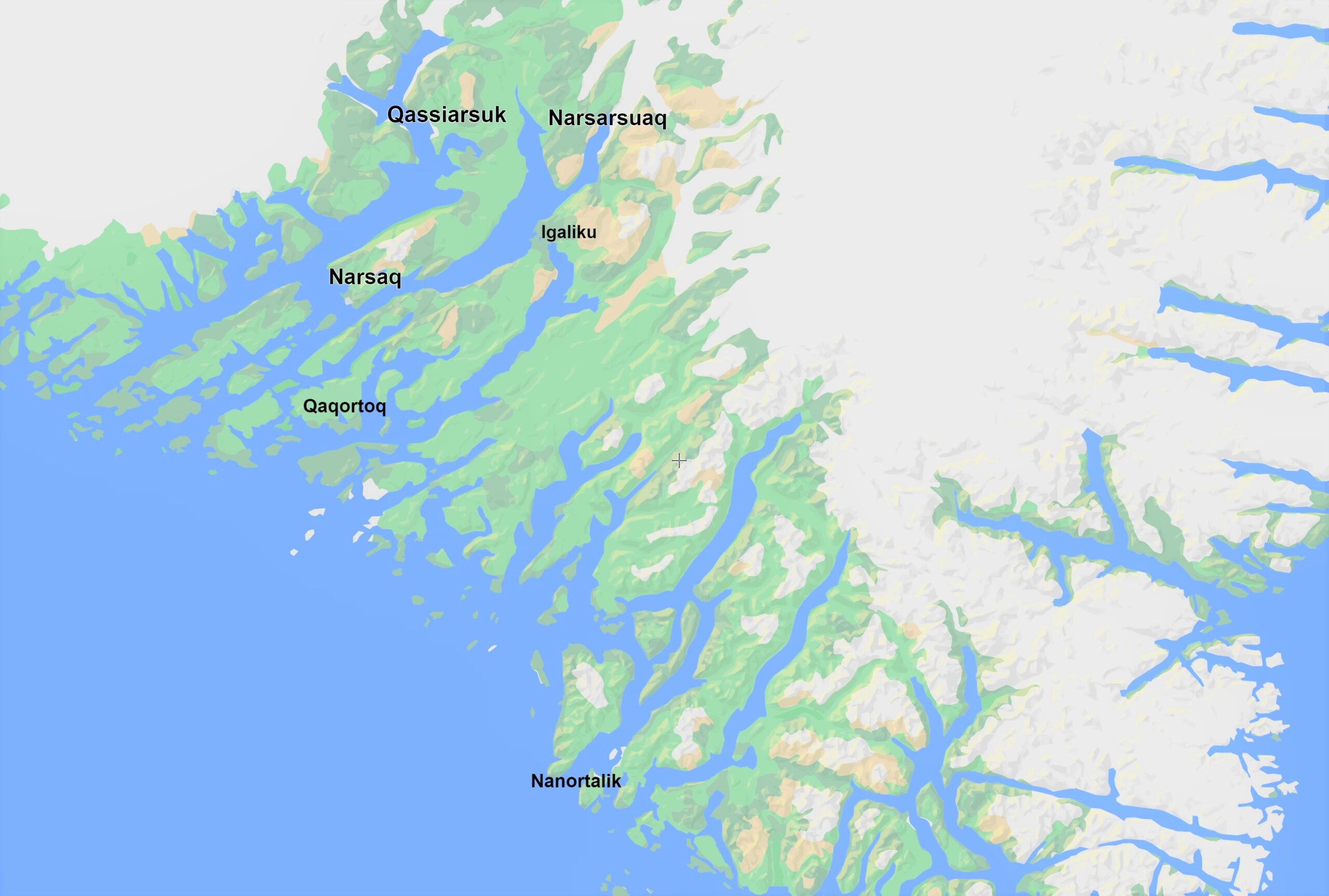

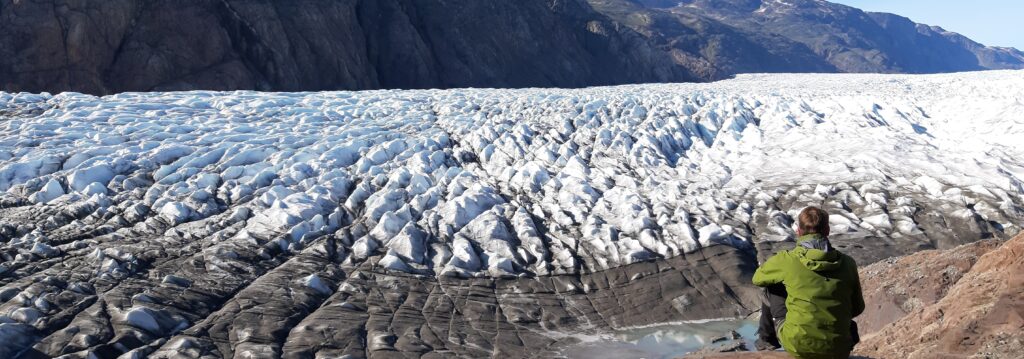

In Narsarsuaq you will find South Greenland’s international airport. Located on a large, flat expanse of glacial till. This is most travellers’ first encounter with South Greenland. There are about 160 inhabitants in the village and, aside from the airport, Narsarsuaq has a hotel, a shop, a school and – during the summer months – a hostel and a café. The airport and many of the buildings in Narsarsuaq were built by the Americans in 1941, when this remote airstrip code-named Bluie West One served as a key base of operations for U.S. aircraft on supply missions between America and Europe. You can find out more about this exciting history at the local museum, which is housed in the same building as the Blue Ice Café and has an impressive collection of photographs and artefacts that date back to this bygone era.
Narsarsuaq is the ideal starting point for excursions in the area. It only takes a few hours of hiking through magnificent scenery before you are rewarded with a view of the ice cap. You can visit the historic sites of Qassiarsuk (Brattahlid) and Igaliku (Gardar) on day trips, and you can join boat trips and helicopter tours to the ice cap.


The village of Qassiarsuk was founded by sheep farmer Otto Frederiksen in 1924. Today about 40 people live there, but the village’s shop, school and church also serve the 12 sheep farms located on the peninsula, which extends all the way to Narsaq. The whole area is dotted with Norse ruins. Archaeologists believe that the stone foundations found in Qassiarsuk are the remains of the Brattahlid farmstead that Erik the Red established in the year 982. In the year 2000, a replica of a Norse longhouse and a small church (Tjodhilde’s Church) were built using traditional sod construction techniques. You can visit the open-air museum on a day trip from Narsarsuaq.
Furthermore, there are some very nice walks along the sheep tracks and gravel roads in the Qassiarsuk area. More adventurous souls may want to tackle the classic multi-day hike to Narsaq. Two hostels and a sheep farm offer accommodation in the village.
UNESCO World Heritage
In 2017 five core areas in South Greenland (including Qassiarsuk) were inscribed in the UNESCO World Heritage List. They represent a unique landscape and fascinating history of farming in the Arctic, dating from the Norse settlement to the present-day Greenlandic sheep farmers.


Igaliku was the first place in South Greenland in recent times to see a return to agriculture as a primary source of income. It was the Norwegian Anders Olsen and his Greenlandic wife Tuperna who established themselves as farmers here in 1782. The first settlers built their houses using stones from the many Norse ruins in the area. These were vestiges of old Gardar, which was the seat of episcopal power under the Vikings. The modern village experienced its heyday in the first half of the 20th century. By 1950 the population counted 150 people who made a living from farming (cattle and sheep), supplemented by hunting and fishing. Today there are about 30 permanent residents, but many former residents and their families have kept their houses in Igaliku as summer residences/cottages, and the village is incredibly quaint and full of life during the summer.
Aside from its fascinating Norse ruins, Igaliku has some of the best hiking tours (day trips) in the area, and you can hike to Qaqortoq in 3-4 days. Igaliku has the Country Hotel, with its cabins and in-house restaurant. A sheep farmer also offers accommodation.
UNESCO World Heritage
In 2017 five core areas in South Greenland (including Igaliku) were inscribed in the UNESCO World Heritage List. They represent a unique landscape and fascinating history of farming in the Arctic, dating from the Norse settlement to the present-day Greenlandic sheep farmers.
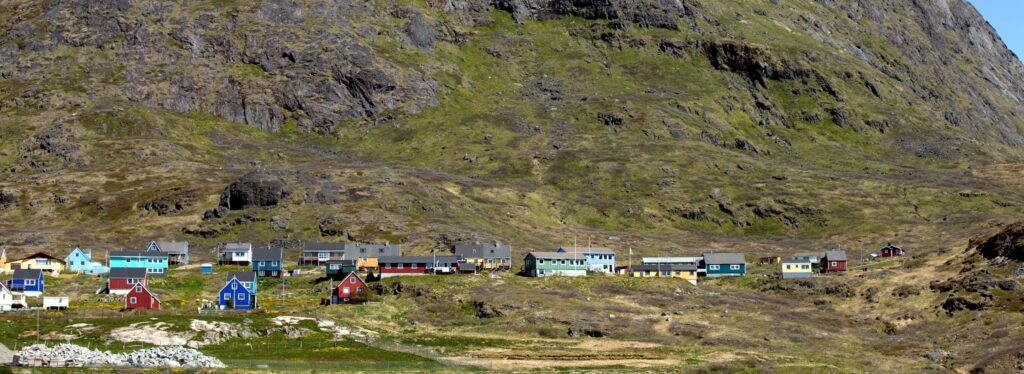

Compared to the other towns in South Greenland, Narsaq is a relatively new community that was established as a trading post (called Nordprøven) in 1830 and not recognized as a town until 1959. Today there are approximately 1,500 inhabitants. The town is beautifully situated at the foot of a mountain and next to a sound, which is always filled with icebergs from the surrounding glaciers. In the backcountry are high mountains, including the famous Kvanefjeld, which contains over 200 different minerals and is a Mecca for anyone interested in geology. There are several nice walks around Narsaq, and many multi-day kayak trips start or end here. In addition, the museum is a magnet for visitors, with some fine exhibits on the Norse, Narsaq’s recent history and the geology in the area, including an excellent collection of minerals and stones.
Narsaq is a natural starting point for tours where you can get a closer look at the ice. Blue Ice offers boat trips to the ice cap (the place called the “Twin Glacier”). Here you can go ashore and literally touch the ice cap!


Qaqortoq was founded in 1775 and it still has many beautiful old colonial buildings clustered around the old town square with its iconic fountain. Today it is South Greenland’s largest town with about 3,300 inhabitants. It is the main centre of education in South Greenland with an upper secondary school, a business school, a vocational school for adults and a school for tourism management and guide training. The many young people give the town a vibrant atmosphere. In addition, Qaqortoq is home to many Greenlandic artists, and they have left their mark on the city. The project “Stone and Man” consists of more than 30 sculptures that are carved into the granite bedrock by various artists. This permanent exhibition makes a stroll around the city a very special experience.
From Qaqortoq you can also visit the famous Hvalsey Church on a short excursion (half an hour by boat one way). This is the best preserved ruin from the Norse period. The trip is occasionally combined with a stop at the Upernaviarsuk agricultural college and research station, where you can see the latest experiments with growing crops and vegetables in the Arctic, both in greenhouses and outdoors.
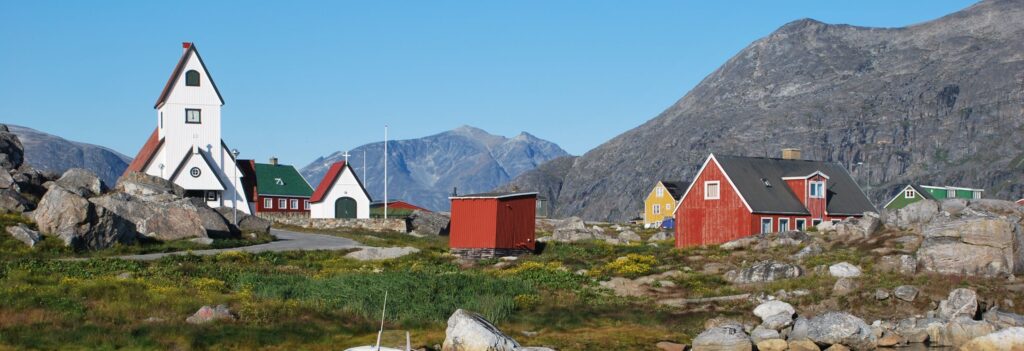

Nanortalik means “where the polar bears go“.
Greenland’s most southerly town got its name from the many polar bears that drift in with the pack ice from East Greenland every spring. The town is a typical Greenlandic community, with wooden houses painted all the colours of the rainbow and a lively harbour area. In the old days, many hunters used to move to the outer islands in the spring to hunt hooded seals that migrate every year with the pack ice. Nanortalik is probably the town in South Greenland that has best maintained this tradition and hunting culture is a part of everyday life for many families. About 1,300 people live in Nanortalik.
The museum is one of the most exciting in Greenland. Several old colonial houses contain exhibits where you can see copies of the famous old Norse clothing from Herjolfsnæs, a collection of kayaks and umiaks (skin boats), an Inuit settlement with sod huts and summer tents and much more. You can take shorter hikes up vantage points, as well as to the original colonial settlement, “old Nanortalik” (“Sissarissoq”), located just a couple of kilometres outside the city.
From Nanortalik you can visit the magnificent Tasermiut Fjord on a boat tour. The steep pointed peaks and vertical granite walls extend nearly 2,000 metres into the sky. The area is world famous among climbers and mountaineers, but you do not have to be quite that ambitious! It is a great experience just to take a boating trip on the fjord or visit one of the local settlements – Tasiusaq, Narsarmijit (Frederiksdal) and Aappilattoq – where it seems as if time has stood still. We recommend that you arrange such trips in advance.
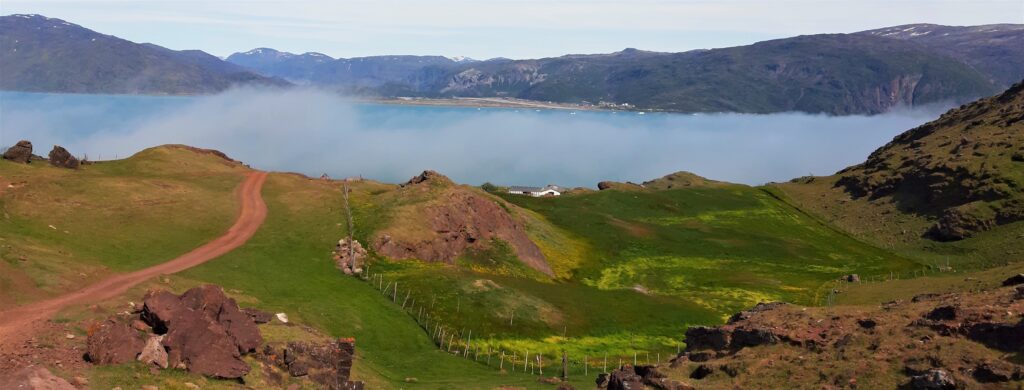

Many sheep farms in South Greenland offer accommodation in the original farmhouses, which usually date back to the 1950s and 1960s and often have been converted into youth hostels. This is something unique to South Greenland and you have the opportunity to stay with a Greenlandic family and get a glimpse of their life. The farm sites are often isolated in stunning scenery, yet completely modern and fully mechanized. A family generally has between 500-600 ewes, some sheep herding dogs, a couple of Icelandic horses and a few chickens. Several farmsteads have also begun to grow vegetables such as potatoes, turnips, lettuce and cabbage. Many sheep farms offer dinner where you can enjoy a meal made with wholesome Greenlandic meat and produce.
- Narsarsuaq
- Qassiarsuk
- Igaliku
- Narsaq
- Qaqortoq
- Nanortalik
- Sheep farms
Narsarsuaq
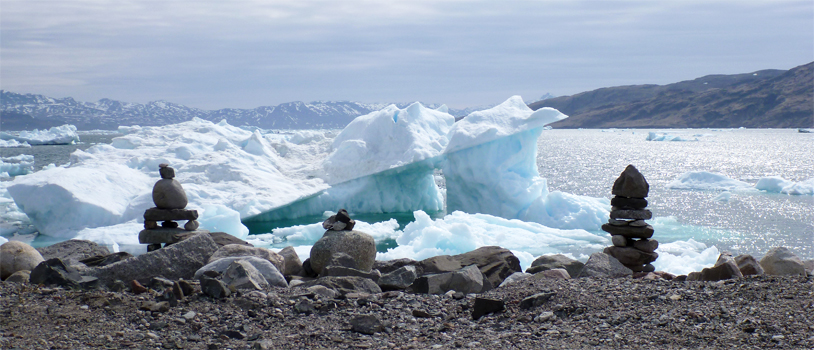

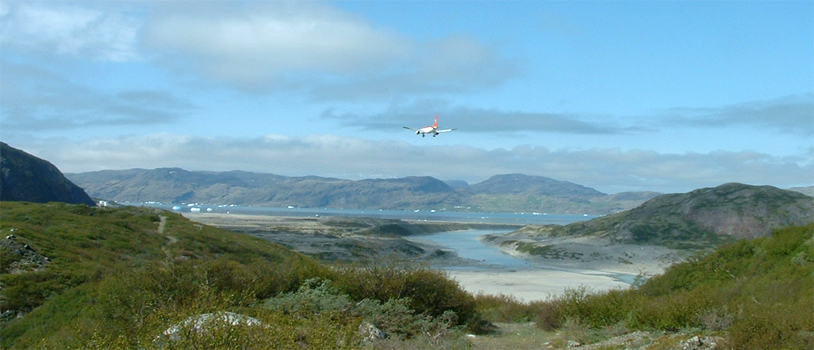

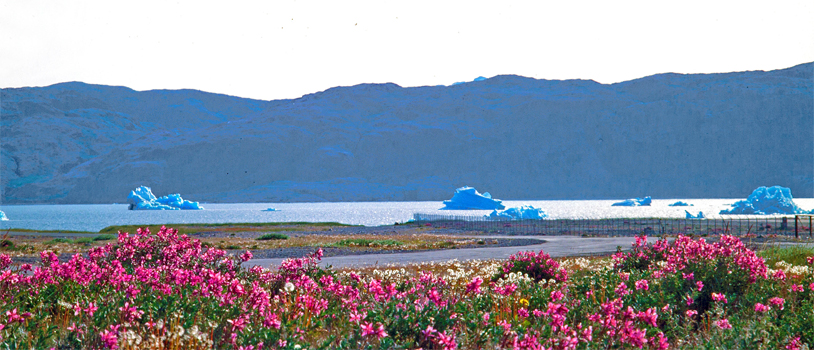

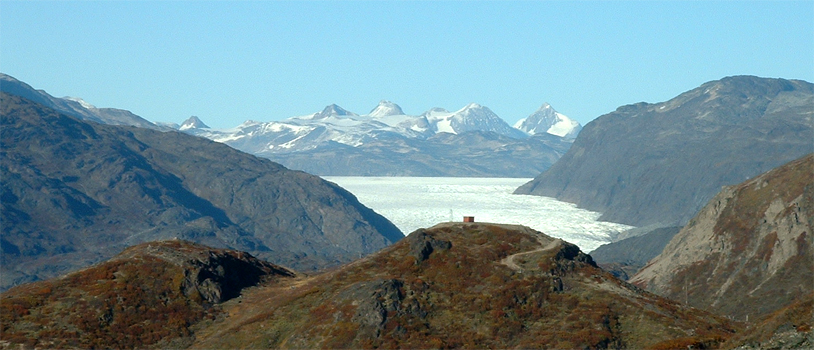

South Greenland’s international airport is located on a large, flat expanse of glacial till. This is most travellers’ first encounter with South Greenland. There are about 160 inhabitants in the village and, aside from the airport, Narsarsuaq has a hotel, a shop, a school and – during the summer months – a hostel and a café. The airport and many of the buildings in Narsarsuaq were built by the Americans in 1941, when this remote airstrip code-named Bluie West One served as a key base of operations for U.S. aircraft on supply missions between America and Europe. You can find out more about this exciting history at the local museum, which is housed in the same building as the Blue Ice Café and has an impressive collection of photographs and artefacts that date back to this bygone era.
Narsarsuaq is the ideal starting point for excursions in the area. It only takes a few hours of hiking through magnificent scenery before you are rewarded with a view of the ice cap. You can visit the historic sites of Qassiarsuk (Brattahlid) and Igaliku (Gardar) on day trips, and you can join boat trips and helicopter tours to the ice cap.
Qassiarsuk (Brattahlid)
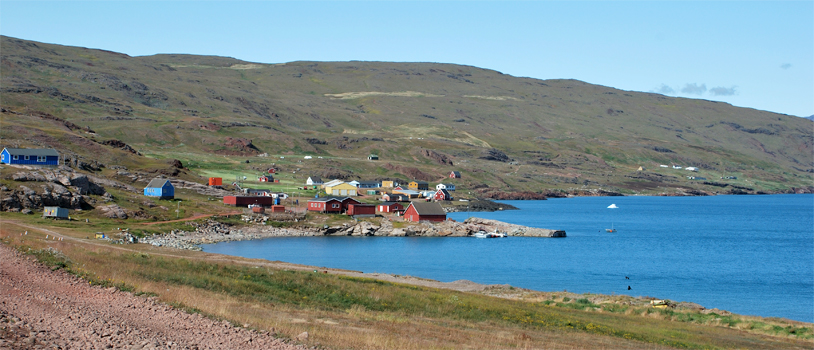

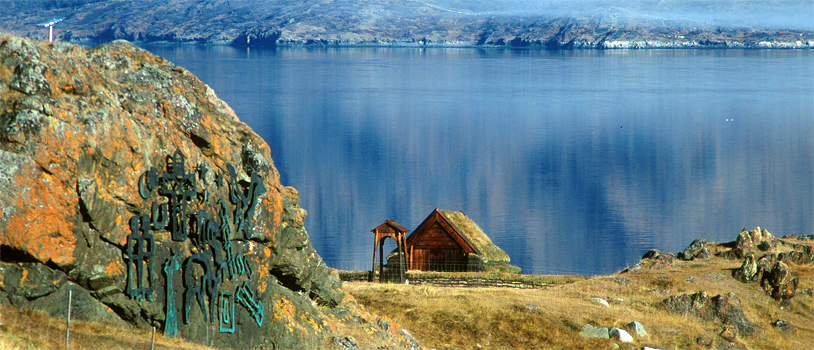



The village of Qassiarsuk was founded by sheep farmer Otto Frederiksen in 1924. Today about 40 people live there, but the village’s shop, school and church also serve the 12 sheep farms located on the peninsula, which extends all the way to Narsaq. The whole area is dotted with Norse ruins. Archaeologists believe that the stone foundations found in Qassiarsuk are the remains of the Brattahlid farmstead that Erik the Red established in the year 982. In the year 2000, a replica of a Norse longhouse and a small church (Tjodhilde’s Church) were built using traditional sod construction techniques. You can visit the open-air museum on a day trip from Narsarsuaq.
Furthermore, there are some very nice walks along the sheep tracks and gravel roads in the Qassiarsuk area. More adventurous souls may want to tackle the classic multi-day hike to Narsaq. Two hostels and a sheep farm offer accommodation in the village.
UNESCO World Heritage
In 2017 five core areas in South Greenland (including Qassiarsuk) were inscribed in the UNESCO World Heritage List. They represent a unique landscape and fascinating history of farming in the Arctic, dating from the Norse settlement to the present-day Greenlandic sheep farmers.
Igaliku (Gardar)




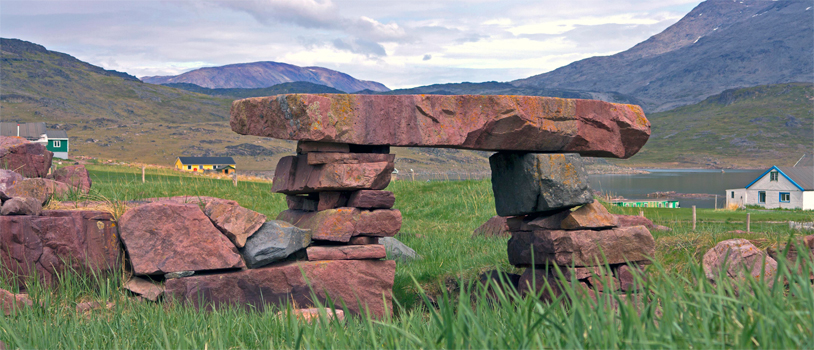

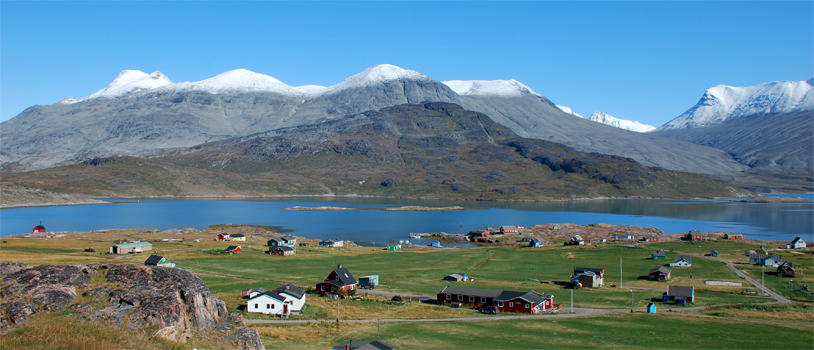

Igaliku was the first place in South Greenland in recent times to see a return to agriculture as a primary source of income. It was the Norwegian Anders Olsen and his Greenlandic wife Tuperna who established themselves as farmers here in 1782. The first settlers built their houses using stones from the many Norse ruins in the area. These were vestiges of old Gardar, which was the seat of episcopal power under the Vikings. The modern village experienced its heyday in the first half of the 20th century. By 1950 the population counted 150 people who made a living from farming (cattle and sheep), supplemented by hunting and fishing. Today there are about 30 permanent residents, but many former residents and their families have kept their houses in Igaliku as summer residences/cottages, and the village is incredibly quaint and full of life during the summer.
Aside from its fascinating Norse ruins, Igaliku has some of the best hiking tours (day trips) in the area, and you can hike to Qaqortoq in 3-4 days. Igaliku has the Country Hotel, with its cabins and in-house restaurant. A sheep farmer also offers accommodation.
UNESCO World Heritage
In 2017 five core areas in South Greenland (including Igaliku) were inscribed in the UNESCO World Heritage List. They represent a unique landscape and fascinating history of farming in the Arctic, dating from the Norse settlement to the present-day Greenlandic sheep farmers.
Narsaq


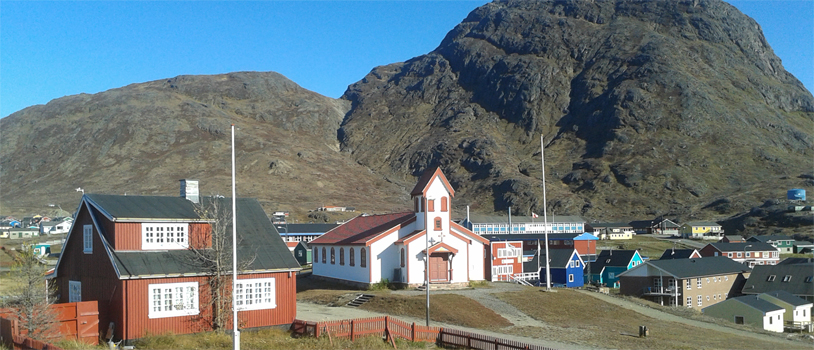

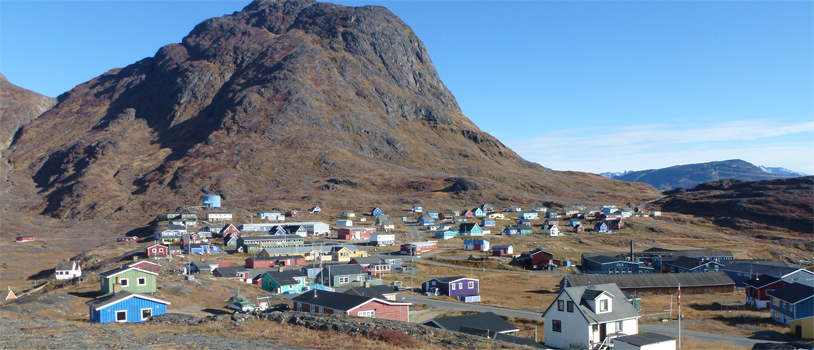

Compared to the other towns in South Greenland, Narsaq is a relatively new community that was established as a trading post (called Nordprøven) in 1830 and not recognized as a town until 1959. Today there are approximately 1,500 inhabitants. The town is beautifully situated at the foot of a mountain and next to a sound, which is always filled with icebergs from the surrounding glaciers. In the backcountry are high mountains, including the famous Kvanefjeld, which contains over 200 different minerals and is a Mecca for anyone interested in geology. There are several nice walks around Narsaq, and many multi-day kayak trips start or end here. In addition, the museum is a magnet for visitors, with some fine exhibits on the Norse, Narsaq’s recent history and the geology in the area, including an excellent collection of minerals and stones.
Narsaq is a natural starting point for tours where you can get a closer look at the ice. Blue Ice offers boat trips to the ice cap (the place called the “Twin Glacier”). Here you can go ashore and literally touch the ice cap!
Qaqortoq
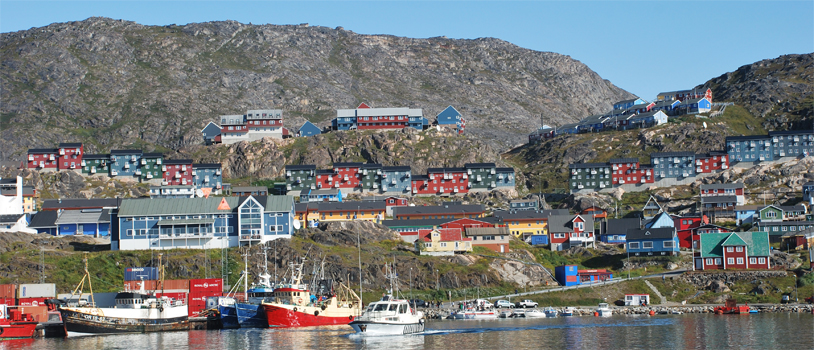





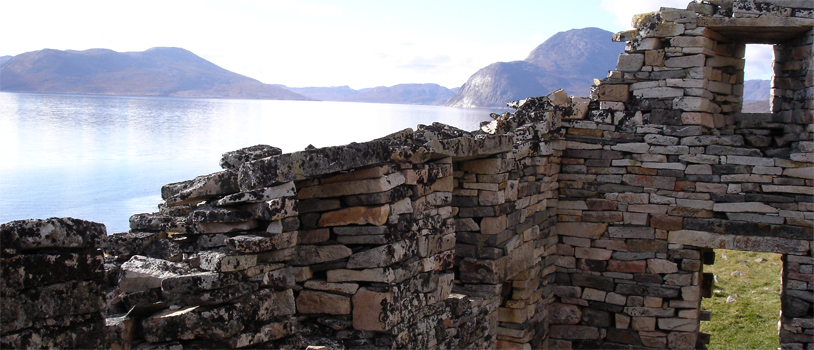

The city was founded in 1775 and it still has many beautiful old colonial buildings clustered around the old town square with its iconic fountain. Today it is South Greenland’s largest town with about 3,300 inhabitants. It is the main centre of education in South Greenland with an upper secondary school, a business school, a vocational school for adults and a school for tourism management and guide training. The many young people give the town a vibrant atmosphere. In addition, Qaqortoq is home to many Greenlandic artists, and they have left their mark on the city. The project “Stone and Man” consists of more than 30 sculptures that are carved into the granite bedrock by various artists. This permanent exhibition makes a stroll around the city a very special experience.
From Qaqortoq you can also visit the famous Hvalsey Church on a short excursion (half an hour by boat one way). This is the best preserved ruin from the Norse period. The trip is occasionally combined with a stop at the Upernaviarsuk agricultural college and research station, where you can see the latest experiments with growing crops and vegetables in the Arctic, both in greenhouses and outdoors.
Nanortalik


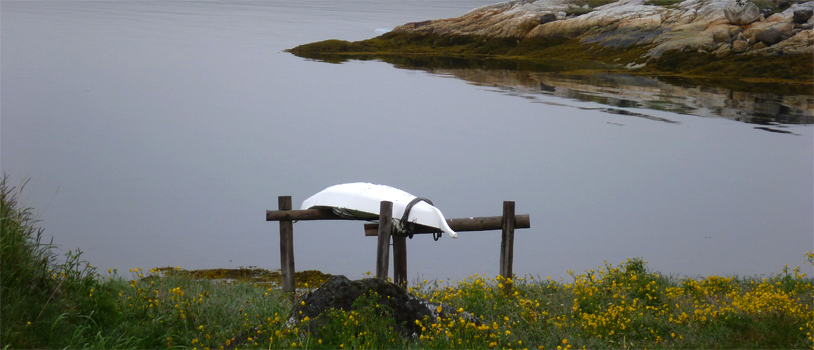

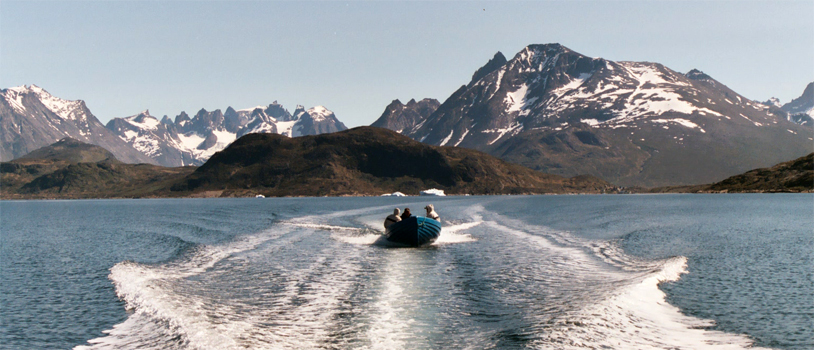

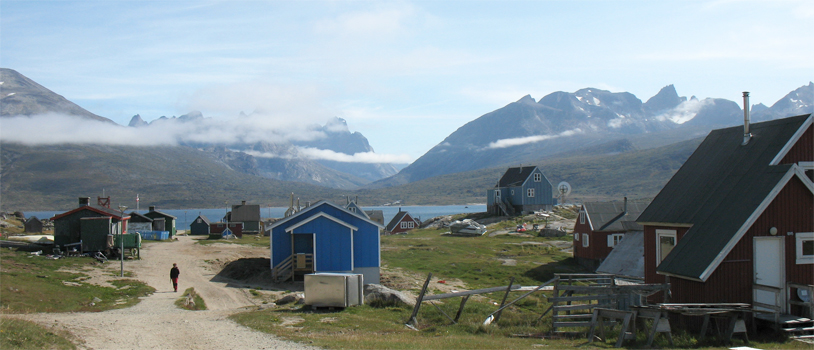

Nanortalik means “where the polar bears go“.
Greenland’s most southerly town got its name from the many polar bears that drift in with the pack ice from East Greenland every spring. The town is a typical Greenlandic community, with wooden houses painted all the colours of the rainbow and a lively harbour area. In the old days, many hunters used to move to the outer islands in the spring to hunt hooded seals that migrate every year with the pack ice. Nanortalik is probably the town in South Greenland that has best maintained this tradition and hunting culture is a part of everyday life for many families. About 1,300 people live in Nanortalik.
The museum is one of the most exciting in Greenland. Several old colonial houses contain exhibits where you can see copies of the famous old Norse clothing from Herjolfsnæs, a collection of kayaks and umiaks (skin boats), an Inuit settlement with sod huts and summer tents and much more. You can take shorter hikes up vantage points, as well as to the original colonial settlement, “old Nanortalik” (“Sissarissoq”), located just a couple of kilometres outside the city.
From Nanortalik you can visit the magnificent Tasermiut Fjord on a boat tour. The steep pointed peaks and vertical granite walls extend nearly 2,000 metres into the sky. The area is world famous among climbers and mountaineers, but you do not have to be quite that ambitious! It is a great experience just to take a boating trip on the fjord or visit one of the local settlements – Tasiusaq, Narsarmijit (Frederiksdal) and Aappilattoq – where it seems as if time has stood still. We recommend that you arrange such trips in advance.
Sheep farms
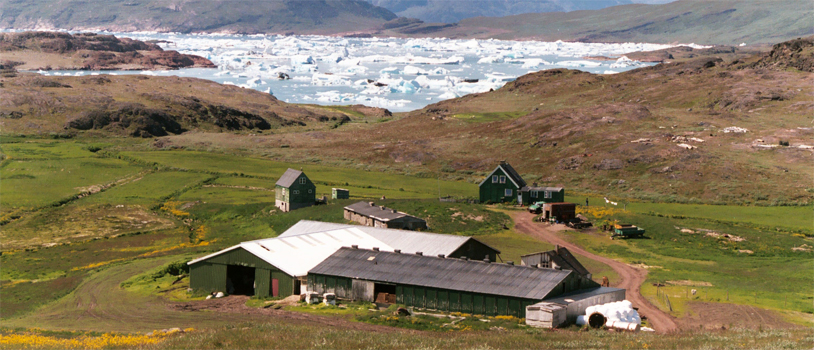

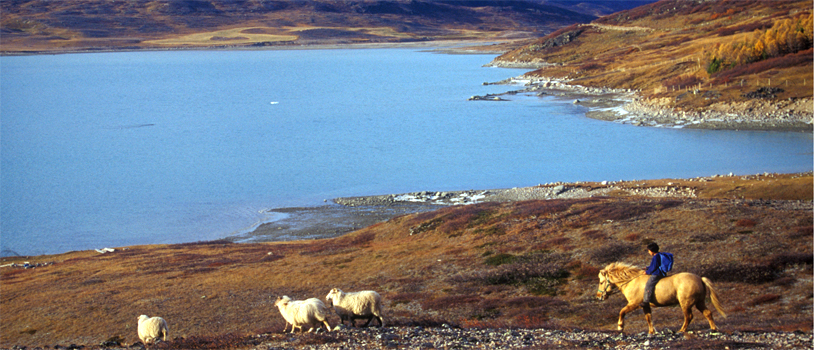

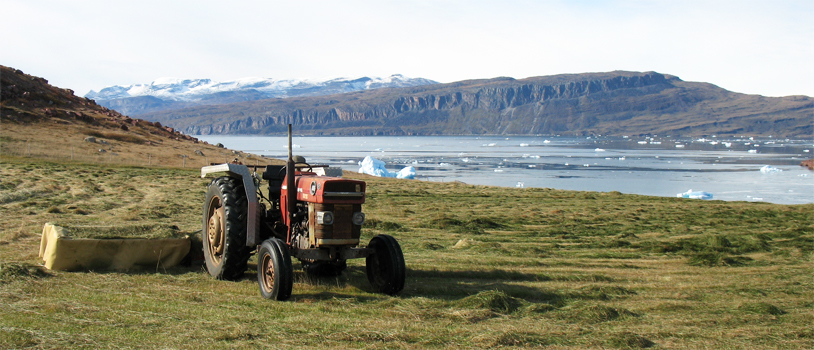

Many sheep farms in South Greenland offer accommodation in the original farmhouses, which usually date back to the 1950s and 1960s and often have been converted into youth hostels. This is something unique to South Greenland and you have the opportunity to stay with a Greenlandic family and get a glimpse of their life. The farm sites are often isolated in stunning scenery, yet completely modern and fully mechanized. A family generally has between 500-600 ewes, some sheep herding dogs, a couple of Icelandic horses and a few chickens. Several farmsteads have also begun to grow vegetables such as potatoes, turnips, lettuce and cabbage. Many sheep farms offer dinner where you can enjoy a meal made with wholesome Greenlandic meat and produce.
